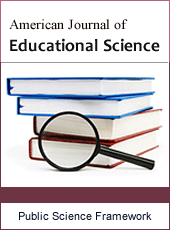American Journal of Educational Science
Articles Information
American Journal of Educational Science, Vol.1, No.4, Sep. 2015, Pub. Date: Jul. 16, 2015
A Review of the Contributions by Women to Urdu Literature in Earlier and Nearby Periods
Pages: 152-158 Views: 5021 Downloads: 5641
[01]
Robina Kausar, Government Islamia College for Women, Department of Urdu, Faisalabad, Punjab, Pakistan.
[02]
Muhammad Sarwar, Pakistan Atomic Energy Commission, Nuclear Institute for Agriculture & Biology, Department of Plant Protection, Faisalabad, Punjab, Pakistan.
[03]
Muhammad Shabbir, Government College for Boys, Department of Statistics, Chak Jhumra, Faisalabad, Punjab, Pakistan.
Urdu literature has a long and colourful history, and it is perhaps the only language that can be enjoyed even if anybody does not understand it. Pakistan’s quest for new ideas on Urdu literature produced some of the most powerful prose and poetry from many excellent writers and poets including women. Although important women writers have appeared before creation of Pakistan, yet the present era saw a proliferation of prose and poetry by women which critiqued the cultural, social and political systems with profound insight and great passion. Speculatively, the reason for the existing of many fine women writers in Pakistan, as compared to almost rare in subcontinent, may be owing to the different ways in which women in Pakistan and Muslim women elsewhere are members of civil society and participate in the public sphere. Within the scope of this paper the main theme is to indicate the key role of women writers and poets, they have played in creating awareness among the folks not only what the womanhood passes through, but also the social constraints that mars their own development. The women faced severe restrictions some decades back to express their thoughts and feelings. But, now many of them have emerged as leading voices in literature and honoured accordingly. Within a lot of cases, the women writers surpassed their male counter parts. The major writers to write as a women appeared before and soon after independence of Pakistan. Among these personalities, Ada Jafri is a first writer who wrote of her experiences as a wife and a mother in a modified traditional idiom. She has been followed by Zehra Nigah, who attempts to portray a desire for a degree of equality of emotional expression in women’s relationships. The two most influential and important women poets who have written deliberately are Kishvar Naheed and Fehmeedah Riyaz, both of whom started writing in the sixties. A younger generation of women writers such as Parveen Shakir, Bano Qudsia and many more took their cue from these predecessors, but more closely examined the subtleties of human and social relations in their writings. This information on Urdu literature would not only create the journalism consciousness among the women, but also open a wide range scope for them to participate in practical lives.
Urdu Prose, Poetry, Education, Muslim Women, Society, Literature, History, Female
[01]
Amber, H. 2004. Psychology from Islamic Perspective: Contributions of Early Muslim Scholars and Challenges to Contemporary Muslim Psychologists. Journal of Religion and Health, 43 (4): 357-377.
[02]
Findley, E.B. 2001. Nur Jehan, Empress of Mughal India. New York: Oxford University Press.
[03]
Gull-i-Hina. 2012. Modernist Trends and varied responses: Reflections on Muslim Women in Urdu Prose by Male authors of South Asia (1900-1936). A Research Journal of South Asian Studies, 27 (2): 459-478.
[04]
Jafri, R. 1997. Female Basic Education in Pakistan. (Draft Paper 7). Lahore: Aurat Foundation.
[05]
Khalid, K., Iram, G.G. and Muhammad, A.H. 2010. A Study of the Representation of Female Image in the Textbooks of English and Urdu at Secondary School Level. Pakistan Journal of Social Sciences, 30 (2): 425-437.
[06]
Muhammad, U.M. 1991. “Introduction,” The Color of Nothingness: Modern Urdu Short Stories. Delhi: Penguin Books. p. xi-xxx.
[07]
Mukhia, H. 2004. The Mughal of India. New Delhi: Oxford University Press.
[08]
Naim, C.M. 1978. Urdu in the Pre-modern Period: Synthesis or Particularism. New Quest (Bombay), No. 6. p. 5-12.
[09]
Nisa, Z. 1989. Discrimination in Education: Content Analysis of Pakistan Textbooks. Working Paper (Series No. 62). The Institute of Social Sciences.
[10]
Omar, Q. 1996. Twentieth-Century Urdu Literature. p. 1-36. Published in Handbook of Twentieth-Century Literatures of India, Ed. by Nalini Natarajan, Greenwood Press, and Westport, CT.
[11]
Robina, K., Sarwar, M. and Shabbir, M. 2015 a. The History of the Urdu Language Together with Its Origin and Geographic Distribution. International Journal of Innovation and Research in Educational Sciences, 2 (1): 5-9.
[12]
Robina, K., Sarwar, M. and Shabbir, M. 2015 b. The Past and Present Trends of the Urdu Literature Collectively with Its Derivation and Geographic Circulation. American Journal of Social Science Research, 1-5.
[13]
Wasti, R. 1987. Biographycal Dictionary of South Asia. Lahore: Ilmi Book Depot.

ISSN Print: 2381-7127
ISSN Online: 2381-7135
Current Issue:
Vol. 6, Issue 2, June Submit a Manuscript Join Editorial Board Join Reviewer Team
ISSN Online: 2381-7135
Current Issue:
Vol. 6, Issue 2, June Submit a Manuscript Join Editorial Board Join Reviewer Team
| About This Journal |
| All Issues |
| Open Access |
| Indexing |
| Payment Information |
| Author Guidelines |
| Review Process |
| Publication Ethics |
| Editorial Board |
| Peer Reviewers |


